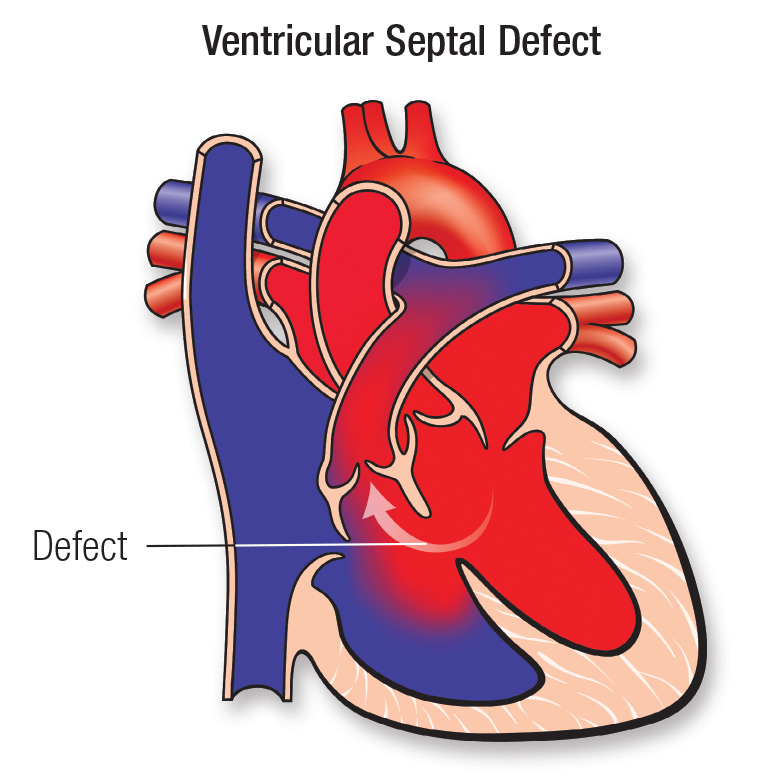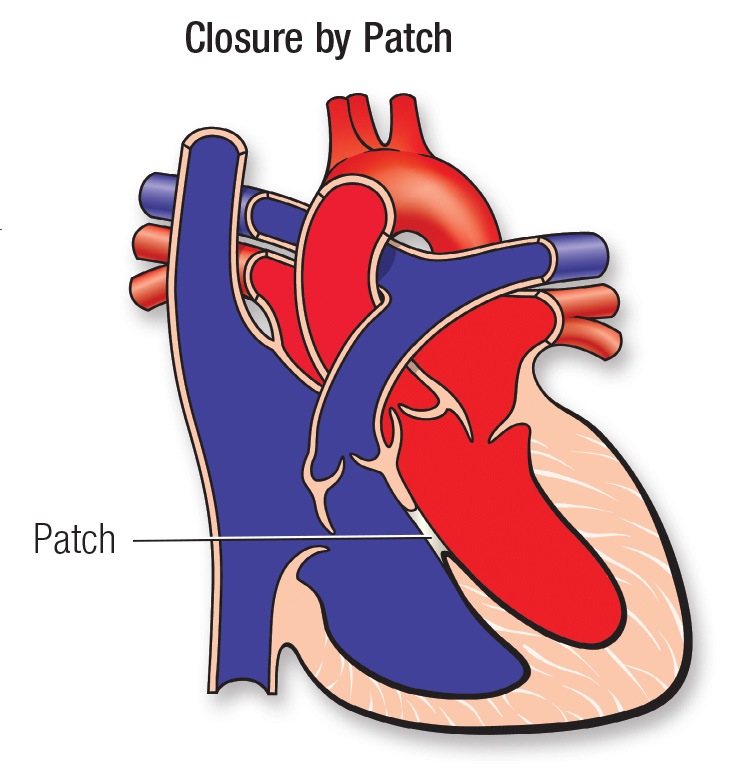Ventricular Septal Defect
What is ventricular septal defect?
Babies born with ventricular (pronounced ven-TRIK-you-lar) septal defect (VSD) have a hole in the wall of their heart between the 2 lower chambers (right and left ventricles). This wall is the ventricular septum.
VSD is often referred to as a hole in the heart. It happens early in the baby’s development when the heart is forming. It is the most common heart birth defect. About 3 in every 1,000 babies have it.
Some children with VSD have other heart defects too, like atrial septal defect. Some have other genetic conditions that increase the risk for VSD, like Down syndrome.

From heart.org. ©2009, American Heart Association, Inc.
-
How does VSD change blood flow?
Normally, oxygen-poor blood comes from the body into the right atrium of the heart. Then it flows into the right ventricle. The right ventricle pumps it to the lungs to get oxygen. Oxygen-rich blood returns from the lungs to the left atrium. Then it flows into the left ventricle, which pumps it out to the rest of the body. Blood cannot pass between the ventricles.
But when there is a hole between the sides of the heart, like in VSD, usually some oxygen-rich blood leaks from the left ventricle into the right ventricle and goes back to the lungs.
-
What problems can VSD cause?
The hole may be small and cause no symptoms, or it may be large and cause serious problems with blood flow. If the hole is large, too much blood will be pumped to the lungs, leading to congestive heart failure.
Also, the heart will have to work harder to pump blood to the body. As a result of the extra work, the heart can get bigger. Over time, this can make it difficult for the heart to work well. Lower heart function can lead to other symptoms and health problems, like poor growth (failure to thrive).
“He is doing so well. He’s such a happy baby who is super smiley and interactive. He is breathing normally and growing like any other child his age.”
Symptoms of Ventricular Septal Defect
A small VSD may cause no symptoms at all. A larger defect may cause symptoms soon after birth.
Children may have symptoms like these:
- Fast breathing or working hard to breathe
- Trouble eating or gaining weight (failure to thrive)
- Frequent respiratory infections
- Arrhythmia
Large defects that are not treated can increase the risk for certain heart or blood problems later in life, like high blood pressure in the lungs (pulmonary hypertension).
Heart Center at Seattle Children's
Diagnosing Ventricular Septal Defect
Sometimes doctors can diagnose VSD in a developing baby before birth. They might first see something different about your baby’s heart on standard prenatal ultrasound. To learn more, you might have a fetal echocardiogram (an ultrasound done to check the heart more closely). Seattle Children’s Fetal Care and Treatment Center team can care for you when you are pregnant if your developing baby has a known or suspected problem.
To diagnose this condition after birth, your child’s doctor will examine your child, check their heartbeat and use a stethoscope to listen to their heart. In children with VSD, doctors can often hear a heart murmur.
The doctor will ask for details about your child’s symptoms, their health history and your family health history.
Your child will most likely need echocardiography and electrocardiogram.
They may occasionally need other tests that provide more information about how their heart looks and works. These include chest X-rays, angiography and cardiac catheterization.
If needed for complex cases, we do 3D imaging, like a CT (computed tomography) scan or MRI (magnetic resonance imaging) of the heart. We can convert these scans into a 3D-printed model of a patient’s heart to prepare for VSD repair and get the best outcomes.
Treating Ventricular Septal Defect
Your child may not need any treatment for VSD. In some children, it does not cause any problems. Or, if the hole is small, it may close on its own as your child grows. So, your child’s doctor may simply recommend checking your child’s condition over time.
 From heart.org. ©2009, American Heart Association, Inc.
From heart.org. ©2009, American Heart Association, Inc.Some children do need treatment because the defect causes troubling or serious symptoms. The position and size of the defect are important factors in deciding which treatment to use.
- Some VSDs are treated using a long, thin tube (catheter) to place a device in the heart that closes the hole in the septum. This is called cardiac catheterization. Children need to reach a certain age and weight in order to have catheterization.
- If the defect is large and close to a heart valve, doctors may not be able to close it using a catheter. Instead, the child will need surgery to close the hole with stitches or a patch and get the blood to flow the correct way.
- Some children who are too young or small for typical catheterization may be able to have a hybrid procedure to avoid open heart surgery. A cardiac surgeon and a cardiologist work together to place the closure device by putting a catheter through the wall of the heart.
Ventricular Septal Defect at Seattle Children’s
-
The experts you need are here
- Our team of more than 40 pediatric cardiologists has experience diagnosing and treating every kind of heart problem.
- Our surgical outcomes are among the best in the nation year after year. See our outcomes for ventricular septal defect repair.
- Our doctors and surgeons are experts in the treatments your child may need. These include using cardiac catheterizationto place a device that closes the hole in the septum, doing surgery to close the hole or doing a hybrid procedure.
- We also have a pediatric cardiac anesthesia team and a Cardiac Intensive Care Unit ready to care for children who have heart surgery.
- Your child’s team includes experts from other areas of Seattle Children’s based on their needs, like doctors who specialize in newborns (neonatologists) or lung health (pulmonologists).
-
Care from fetal diagnosis through young adulthood
- If your developing baby is diagnosed with VSD before birth, our Fetal Care and Treatment Center team works closely with you and your family to plan and prepare for any care your baby may need.
- Your child’s treatment plan is custom-made. We plan and carry out their treatment based on the specific details of their heart defect. We closely check your child’s needs to make sure they get the care that is right for them at every age.
- We have a special Adult Congenital Heart Disease Program to meet your child’s long-term healthcare needs. This program, shared with the University of Washington, transitions your child to adult care when they are ready.
-
Support for your whole family
- We are committed to your child’s overall health and well-being and to helping your child live a full and active life.
- Whatever types of care your child needs, we will help your family through this experience. We will discuss your child’s condition and treatment options in ways you understand and involve you in every decision.
- Our Child Life specialists know how to help children understand their illnesses and treatments in ways that make sense for their age.
- Seattle Children’s has many resources, from financial to spiritual, to support your child and your family and make the journey as smooth as possible.
- Many children and families travel to Seattle Children’s for heart surgery or other care. We help you coordinate travel and housing so you can stay focused on your child.
- Read more about the supportive care we offer.
-
Research to improve care
- We take part in multicenter studies and do our own studies to learn more about the best imaging methods and care options to improve outcomes for children with VSD.
- Using 3D-printed models, our surgeons can plan and prepare for procedures to repair complex heart defects, including VSD. Our research shows these models also help families understand what is happening inside their child’s heart.
Contact Us
Contact the Heart Center at 206-987-2515 for an appointment, second opinion or more information.
Providers, see how to refer a patient.
Related Links
Paying for Care
Learn about paying for care at Seattle Children’s, including insurance coverage, billing and financial assistance.


